Table of Contents
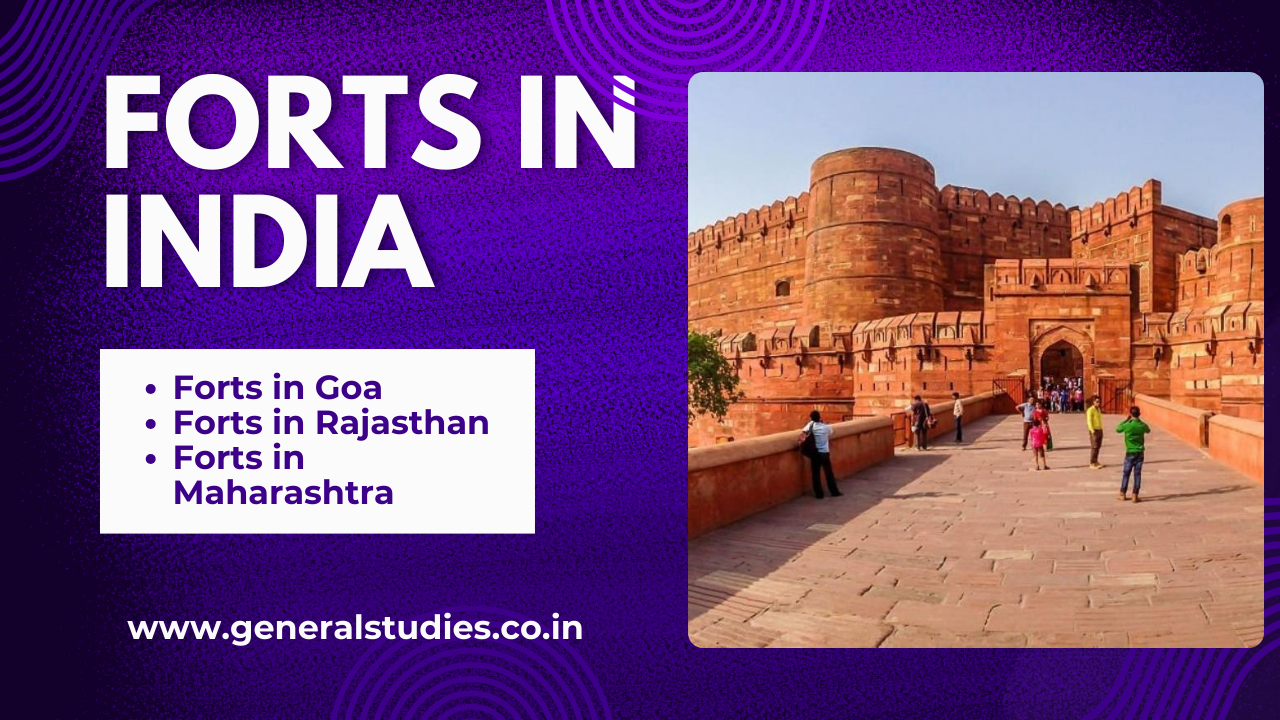
Introduction: Forts in India
India has a rich history of fortifications, owing to its strategic importance over millennia. These forts in India served various purposes, including defense, administration, and as symbols of power.
Forts in India vary in architecture, reflecting the diverse cultural influences prevalent in different regions and eras. From the opulent Mughal forts adorned with intricate carvings and grand palaces to the rugged hill forts of Rajasthan characterized by massive ramparts and sturdy fortifications.
List of Forts in India
Forts in Rajasthan (Forts in India)
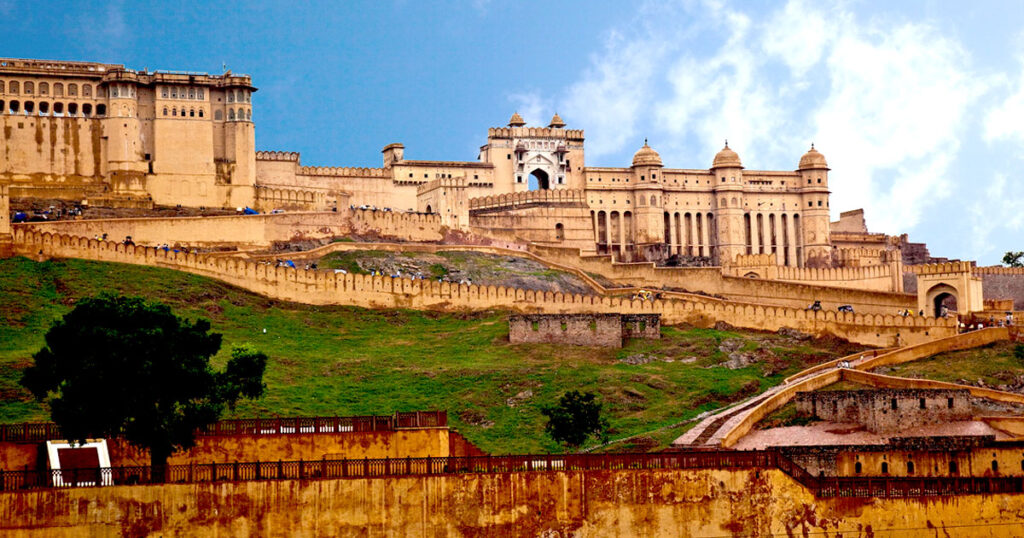
| Name of the Forts in India | Location & Builder (Forts in India) | Period, Important Points(Forts in India) |
|---|---|---|
| Amber Fort Forts in India | Amer, Jaipur; Built by Raja Man Singh | 1592; Rajput & Mughal; Known for Mirror work in Sheesh Mahal, Positioned atop a hill, situated on the banks of Maota Lake; Recognized a UNESCO World Heritage Site as part of the Hill Forts of Rajasthan in 2013. |
| Chittorgarh Fort | Chittorgarh; Initially built by the Mauryan Dynasty | 7th century; Rajput; Largest fort in India, UNESCO World Heritage Site (Hill Forts of Rajasthan) Location: Chittorgarh Fort is situated atop a hill, covering an area of approximately 700 acres, in the city of Chittorgarh, which is in the southeastern part of Rajasthan. History: Chittorgarh Fort has a long history, dating back to the 7th century AD. It was the capital of the Mewar kingdom ruled by the Sisodia Rajputs. The fort was the site of several battles and sieges throughout its history. Architecture: The fort is renowned for its impressive architecture, encompassing several palaces, temples, towers, and reservoirs within its walls. Key Structures: Within the fort complex, notable structures include the Vijay Stambh (Victory Tower), Kirti Stambh (Tower of Fame), Rana Kumbha Palace, Padmini Palace, and various temples dedicated to Hindu deities. Vijay Stambh: The Vijay Stambh, or Tower of Victory, is one of the most iconic structures within the fort. It was built by Rana Kumbha in the 15th century to commemorate his victory over the combined forces of Malwa and Gujarat. Kirti Stambh: The Kirti Stambh, or Tower of Fame, is another prominent tower within the fort complex. It is dedicated to the Jain Tirthankara Adinath and features intricate carvings and sculptures. Padmini Palace: The Padmini Palace is associated with the legendary Queen Padmini, whose beauty is said to have sparked the siege of Chittorgarh by Alauddin Khalji in the 14th century. |
| Jaisalmer Fort | Jaisalmer; Built by Rawal Jaisal | 1156 AD; Rajput; Living fort, known as Sonar Quila (Golden Fort); UNESCO World Heritage Site (Hill Forts of Rajasthan) |
| Mehrangarh Fort | Jodhpur; Built by Rao Jodha | 1459 AD; Rajput; Located on a 400 ft hill, impressive courtyards and palaces; Tentative list for UNESCO World Heritage Site |
| Kumbhalgarh Fort | Kumbhalgarh Fort is situated atop the Aravalli Range, approximately 84 kilometers northwest of Udaipur, in Rajasthan; Built by Rana Kumbha | 15th century; Rajput; UNESCO World Heritage Site (Hill Forts of Rajasthan) Great Wall of India: It is also known as the Great Wall of India. The wall of Kumbhalgarh Fort is the second longest continuous wall in the world, spanning 38 kilometers, second only to the Great Wall of China. |
| Ranthambore Fort | Sawai Madhopur; Built by Chauhan Rajputs | 10th century; Rajput; Located in Ranthambore National Park, panoramic views; UNESCO World Heritage Site (Hill Forts of Rajasthan) |
| Gagron Fort | Jhalawar; Built by Bijaldev | 12th century; Rajput; Surrounded by water on three sides (Jal Durg); UNESCO World Heritage Site (Hill Forts of Rajasthan) |
| Taragarh Fort | Bundi; Built by Rao Deva | 1354 AD; Rajput; One of the oldest forts in Rajasthan, panoramic view of Bundi city; Part of Tentative UNESCO World Heritage Site |
| Junagarh Fort | Bikaner; Built by Raja Rai Singh | 1594 AD; Rajput; Intricate stone carvings, palaces like Anup Mahal and Phool Mahal; – |
| Nahargarh Fort | Jaipur; Built by Sawai Jai Singh II | 1734 AD; Indo-European; Overlooks the city of Jaipur, connected with Amer Fort; Part of Tentative UNESCO World Heritage Site |
Forts in Maharashtra
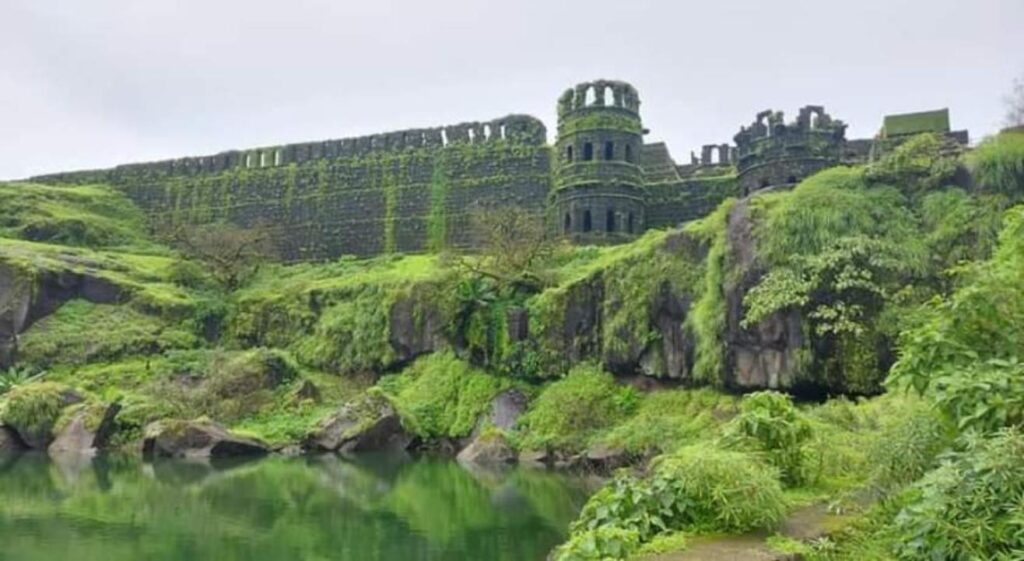
| Fort Name Forts in India | Location & Builder Forts in India | Period, Important Points Forts in India |
|---|---|---|
| Raigad Fort | Raigad; Rebuilt by Chhatrapati Shivaji Maharaj | 1674 AD; Capital of the Maratha Empire, site of Shivaji’s coronation; Part of the tentative list for UNESCO World Heritage Site. |
| Sinhagad Fort | Pune; Initially built by the Koli tribal chieftains, later captured by Shivaji Maharaj | 14th century; Known for the Battle of Sinhagad (1670), steep slopes and cliff-side construction. |
| Pratapgad Fort | Satara; Built by Chhatrapati Shivaji Maharaj | 1656 AD; Site of the famous battle between Shivaji Maharaj and Afzal Khan. |
| Shivneri Fort | Junnar, Pune; Birthplace of Chhatrapati Shivaji Maharaj | 17th century; Birthplace of Chhatrapati Shivaji Maharaj, strategic military location. |
| Rajgad Fort | Pune; Built by Chhatrapati Shivaji Maharaj | 1648 AD; Capital of the Maratha Empire before Raigad, panoramic views, vast structure. |
| Torna Fort | Pune; Captured by Chhatrapati Shivaji Maharaj | 1643 AD; First fort captured by Shivaji Maharaj, massive structure, known as Prachandagad. |
| Lohagad Fort | Lonavala; Built by the Satavahanas, later captured by Shivaji Maharaj | 1st century AD; UNESCO recognized Western Ghats, monsoon trek destination, historical significance; UNESCO World Heritage Site (part of Western Ghats). |
| Purandar Fort | Pune; Built by the Yadava dynasty, later expanded by Shivaji Maharaj | 13th century; Site of the Treaty of Purandar (1665), birthplace of Sambhaji Maharaj; |
| Vijaydurg Fort | Sindhudurg; Built by Raja Bhoj II, later expanded by Shivaji Maharaj | 12th century; Oldest fort on the Sindhudurg coast, known for naval battles, 320 ft underwater wall. |
| Sindhudurg Fort | Malvan; Built by Chhatrapati Shivaji Maharaj | 1664 AD; Maratha; Coastal fort, houses a rare temple dedicated to Shivaji Maharaj, strategic naval base. |
Forts in Goa
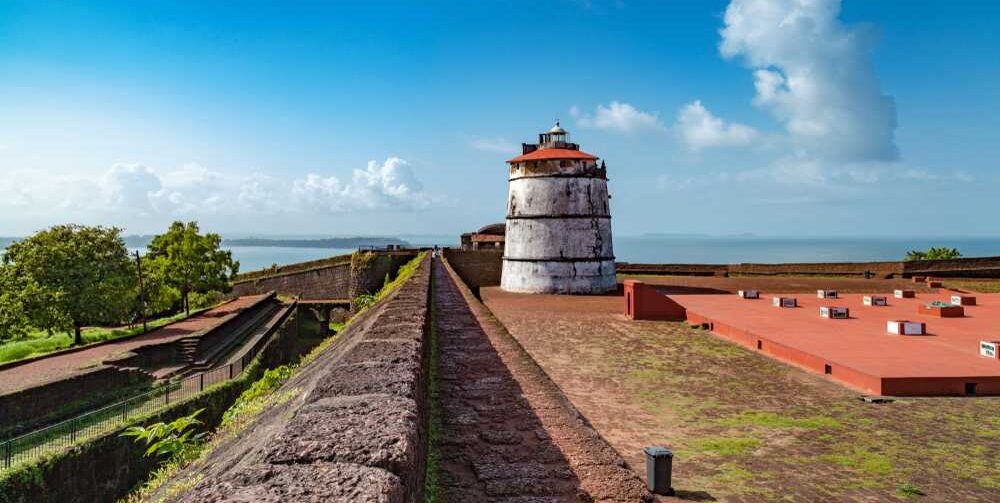
| Fort Name Forts in India | Location & Builder Forts in India | Period/Important Points about the Forts in IndiaForts in India |
|---|---|---|
| Aguada Fort | Sinquerim, North Goa; Built by the Portuguese | 1612 AD; Portuguese; Largest water reservoir in a fort, lighthouse, strategic defense against the Dutch and Marathas. |
| Chapora Fort | Chapora, North Goa; Built by the Portuguese | 1717 AD; Portuguese; Overlooks Chapora River, popularized by Bollywood, scenic views. |
| Reis Magos Fort | Bardez, North Goa; Built by the Portuguese | 1551 AD; Portuguese; Oldest fort in Goa, later used as a residence for viceroys and a prison, now a cultural centre. |
| Cabo de Rama Fort | Canacona, South Goa; Originally built by local rulers, rebuilt by the Portuguese | 1763 AD; Portuguese; Associated with the Ramayana, panoramic views of the Arabian Sea, church within the fort. |
| Tiracol Fort | Tiracol, North Goa; Built by the Marathas, later occupied by the Portuguese | 17th century; Maratha/Portuguese; Located on a cliff overlooking the Arabian Sea, now houses a heritage hotel. |
| Mormugao Fort | Mormugao, South Goa; Built by the Portuguese | 1624 AD; Portuguese; Controlled the entrance to the Mormugao harbour, significant in Portuguese defence. |
| Anjediva Fort | Anjediva Island, off the coast of Karwar; Built by the Portuguese | 1505 AD; Portuguese; One of the earliest Portuguese forts in India, important for naval operations, now abandoned. |
| Rachol Fort | Rachol, South Goa; Built by the Portuguese | 1521 AD; Portuguese; Historic battles between the Portuguese and Bijapur Sultanate, ruins now visible. |
List of Other Forts in India
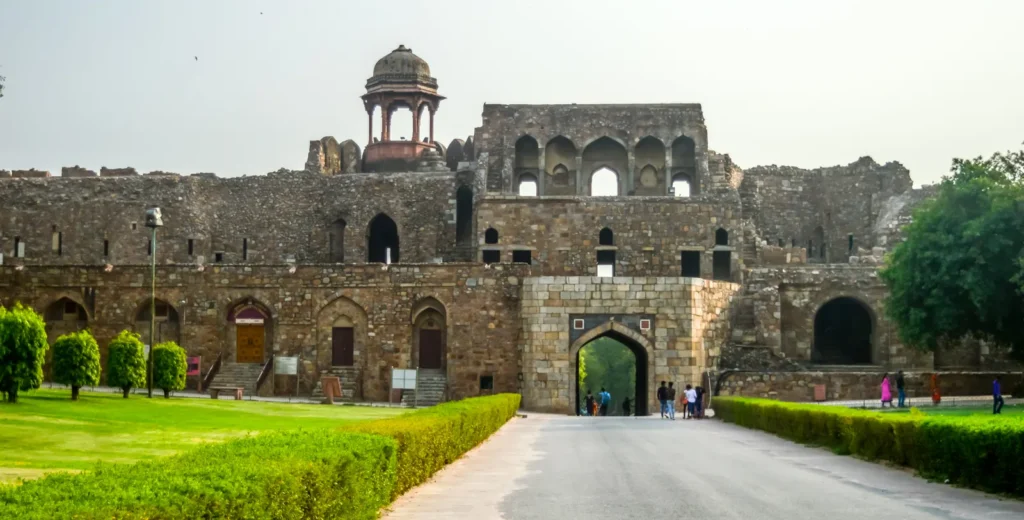
| Name of the Forts in India | Important Points about the Forts in India Forts in India |
|---|---|
| Bidar Fort | Location: Bidar Fort is located in the city of Bidar, in the northern part of Karnataka. Construction: The fort was built during the Bahmani Sultanate period in the 15th century, with subsequent expansions and renovations by various rulers, including the Barid Shahi dynasty. Architecture: Bidar Fort showcases a blend of Persian, Turkish, and Indian architectural styles. |
| Gingee Fort | Location: Gingee Fort is situated in the town of Gingee in the Villupuram district of Tamil Nadu. History: The fort has a rich history dating back to the 9th century when it was originally built by the Chola dynasty. It later came under the control of various rulers, including the Vijayanagara Empire, the Nayakas, and the Marathas. It is built on three hills Krishnagiri, Rajagiri, and Chandrayandurg which are interconnected by walls and fortifications. |
| Barabati Fort | Location: Barabati Fort is located in Cuttack, Odisha, near the banks of the Mahanadi River. History: The fort has a long history dating back to ancient times. It was initially built by the rulers of the Ganga dynasty in the 9th century and later served as a stronghold for various dynasties, including the Gajapati rulers of Odisha. |
| Warangal Fort | Location: Warangal Fort is situated in the city of Warangal, Telangana. History: The fort has a rich history dating back to the Kakatiya dynasty, which ruled the region from the 12th to the 14th centuries. It served as the capital of the Kakatiya kingdom. |
| Fort Aguada | Location: Fort Aguada is situated in Candolim, Goa, India, on the coast of the Arabian Sea. History: The fort was constructed by the Portuguese in 1612, to guard against Dutch and Maratha invasions and to protect the Portuguese territories in Goa. Lighthouse: The historic lighthouse within the fort, built in the 19th century, served as a navigational aid for ships entering the port of Goa. Water Reservoir: The name “Aguada” means “watering place” in Portuguese. The fort has a large underground water reservoir that could store approximately 2,376,000 gallons of fresh water, ensuring a sustainable water supply for the garrison stationed at the fort. Prison: During the Portuguese colonial period, Fort Aguada was used as a prison. |
| Kangra Fort | Location: Kangra Fort is located in the town of Kangra in the Kangra district of Himachal Pradesh. It is the largest fort in the Himalayas and possibly the oldest dated fort in India. History: The Kangra Fort was constructed by the royal Rajput family of Kangra State, known as the Katoch dynasty. |
| Vellore Fort | Location: Vellore Fort is located in the city of Vellore in Tamil Nadu. History: It was constructed by the Nayakar chieftains of the Vijayanagara Empire. It later came under the control of various rulers, including the Marathas, the Carnatic Nawabs, and the British East India Company. Mutiny of 1806: Vellore Fort is known for the Vellore Mutiny of 1806, a rebellion by Indian sepoys against the British East India Company’s rule. |
| Gulbarga Fort | Location: Gulbarga Fort is located in the city of Gulbarga (now Kalaburagi) in Karnataka. History: Gulbarga Fort was built in 14th century by the Bahmani Sultanate. It served as a stronghold for various dynasties, including the Bahmani Sultanate, the Adil Shahi dynasty, and the Bijapur Sultanate. |
| Chandragiri Fort | Location: Chandragiri Fort is situated in the Chittoor district of Andhra Pradesh, near Tirupati. History: Chandragiri Fort was constructed by the Yadava Naidu rulers in the 11th century. It later came under the control of the Vijayanagara Empire and served as a secondary capital for the empire during the rule of King Sri Ranga Raya. |
| Talatal Ghar | Location: Talatal Ghar is located in the town of Sivasagar, Assam. History: Talatal Ghar was constructed during the rule of the Ahom dynasty in the 18th century. It served as a royal residence, military outpost, and administrative center for the Ahom kings. |
| Salimgarh Fort | Salimgarh Fort (Salim’s Fort) was built in 1546 AD, in Delhi by Salim Shah Suri, son of Sher Shah Suri. |
| Fort William | Location: The fort is situated on the eastern bank of the Hooghly River in Kolkata. Construction: Fort William was built by the British East India Company in the late 17th century. Construction began in 1696 and was completed in 1706 under the supervision of John Goldsborough, the then-chief engineer of the company. Purpose: The primary purpose of Fort William was to serve as a military base and administrative center for the British East India Company in Bengal. It played a crucial role in defending British interests in the region and maintaining control over the lucrative trade routes. Siege of 1756: Fort William is famously associated with the Siege of Calcutta in 1756, during which Nawab Siraj-ud-Daulah, the ruler of Bengal, captured the fort after defeating the British forces. |
| Munger Fort | Location: Munger Fort is situated atop a hill on the south bank of the Ganga River in Bihar. |
| Bekal Fort | Location: Bekal Fort is situated on the Malabar Coast. It is located near the town of Bekal, approximately 16 kilometres south of Kasaragod town, Kerala. |
| Janjira Fort | Location: Janjira Fort is situated on an island called Murud-Janjira, which is located in the Arabian Sea, off the Konkan coast of Maharashtra. History: It is believed to have been built in the late 15th or early 16th century by Malik Ambar, an Abyssinian slave who rose to become a prominent general and administrator in the Ahmednagar Sultanate. The fort was later controlled by the Siddis, who were African-descended rulers of Janjira State. |
| Purana Qila | History: The fort’s origins date back to the 16th century when it was constructed by the Mughal emperor Humayun. However, archaeological evidence suggests that the site has been continuously inhabited for over 2,500 years, with traces of settlements from the Mauryan period being found. Significant Structures: Inside the fort, there are several notable structures, including the Qila-i-Kuhna Mosque, which was built by Sher Shah Suri, and the Sher Mandal, a two-story octagonal tower where Emperor Humayun fell to his death in 1556. |
| Agra Fort | Location: Agra Fort is situated in the city of Agra, about 2.5 km northwest of the Taj Mahal. Historical Residence: It served as the primary residence for the Mughal emperors till 1638. After that, the capital was shifted to Delhi. UNESCO World Heritage Site: Agra Fort is designated as a UNESCO World Heritage site. |
| Red Fort | Location: Located in Old Delhi, India. History: Red Fort, also known as Lal Qila, was built by the Mughal Emperor Shah Jahan in the 17th century as the royal residence of the Mughal dynasty. It served as the main residence of the emperors for nearly 200 years until the British colonial era. |
| Daulatabad Fort | Location: Situated in Hyderabad, Telangana, India. History: Golkonda Fort was originally built during the Kakatiya dynasty in the 13th century but was later expanded and fortified by the Qutb Shahi dynasty. It served as a major centre for the diamond trade and was renowned for its impregnable defences. |
| Fort St. George | Location: Located in Chennai (Madras), Tamil Nadu, India. History: Fort St. George was built by the British East India Company in the 17th century as their first fortress in India. It served as the administrative and military headquarters of the British in South India during the colonial period. |
| Golkonda Fort | Location: Junagadh, Gujarat. History: Uparkot Fort has a history dating back over two millennia and has been associated with various rulers, including the Mauryas, the Gupta Empire, the Chudasama dynasty, and the Mughals. It served as a strategic military outpost and a centre of administration. |
| Kalinjar Fort | Location: Located in the Kalinjar region of Uttar Pradesh, India. History: Kalinjar Fort has a history dating back to ancient times and has been associated with various rulers, including the Chandela dynasty, the Pratiharas, the Delhi Sultanate, and the Bundela Rajputs. It served as a strategic military stronghold. |
| Chitradurga Fort | Location: Chitradurga, Karnataka. History: Chitradurga Fort was built in stages by the dynasties that ruled the region, including the Chalukyas, Hoysalas, and Vijayanagara Empire. |
| Uparkot Fort | Location: Junagadh, Gujarat. History: Uparkot Fort has a history dating back over two millennia and has been associated with various rulers, including the Mauryas, the Gupta Empire, the Chudasama dynasty, and the Mughals. It served as a strategic military outpost and a centre of administration. |
| Gwalior Fort | Location: Gwalior, Madhya Pradesh. History: Gwalior Fort has a history dating back over 1,000 years and has been associated with various rulers, including the Tomaras, the Mughals, the Marathas, and the British. It served as a strategic military stronghold and a center of power in central India. |
| Raigad Fort | Location: Raigad district of Maharashtra. History: Raigad Fort was built by the Maratha ruler Chhatrapati Shivaji Maharaj in the 17th century and served as the capital of the Maratha Empire. It is known for its steep fortifications and played a crucial role in Maratha history. Takmak Tok: The Takmak Tok, also known as the Punishment Point, is a cliff edge from where Shivaji Maharaj administered justice by throwing criminals to their death. |
| Nahargarh Fort | Location: Jaipur, Rajasthan. History: Nahargarh Fort was built in the 18th century by Maharaja Sawai Jai Singh II of Jaipur. It served as a defensive fortification and is known for its stunning views of the Jaipur cityscape. |
| Fort Dansborg | Location: Fort Dansborg, also known as Danish Fort, is a historic fort located in the town of Tranquebar (Tharangambadi) in the Nagapattinam district of Tamil Nadu. History: The fort was built by the Danish East India Company in 1620 under the leadership of Ove Gjedde, a Danish admiral and governor. It served as a trading post and a military stronghold for the Danish settlement in Tranquebar. Architecture: Fort Dansborg is designed in a typical European military style of the 17th century, featuring thick walls, bastions, and cannons. It originally had four corner bastions and a central courtyard. Purpose: The fort was established to facilitate trade between Denmark and India, particularly in textiles, spices, and other commodities. It also served as a defensive structure to protect Danish interests in the region. Captures and Surrenders: The fort witnessed several changes in ownership during its history. It was captured by the British in 1801 during the Napoleonic Wars and later restored to the Danish in 1814. In 1845, Tranquebar was sold to the British East India Company. |
| Bhatinda Fort | Location: Bhatinda Fort, also known as Qila Mubarak, is a historic fort located in the city of Bathinda in the Indian state of Punjab. History: The fort has a rich history dating back over 1,900 years. It was originally built by the Kushan emperor Kanishka in the 2nd century CE. Over the centuries, it was occupied and renovated by various rulers, including the Rajputs, the Ghaznavids, the Mughals, Sikhs and the British. Razia Sultana, the Empress of Delhi Sultanate had been imprisoned in Quila Mubarak. |
| Bhadra Fort | Location: Bhadra Fort is located in the heart of the city of Ahmedabad, Gujarat. History: The fort was built in the 15th century by Sultan Ahmad Shah I, the founder of Ahmedabad, as his royal residence and seat of power. |